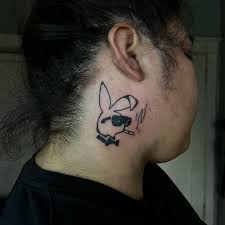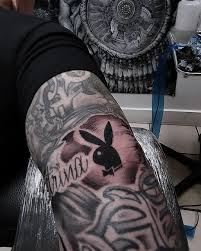In the realm of tattoos, countless designs signify deep meanings, artistic expressions, or sometimes, just a love for a certain brand. Enter the Playboy tattoo, a symbol that has graced the bodies of many since the icon’s inception. But is it ever okay for a man to get a Playboy tattoo? Let’s dive into the world of Playboy, explore its iconic status, and answer this pressing question with a hint of humor.
The Origin of the Playboy Empire
The Playboy brand, synonymous with luxury, sophistication, and a dash of risqué, was birthed by Hugh Hefner in the 1950s. Originally a magazine, Playboy quickly became known for more than its articles; it represented a particular lifestyle and viewpoint on freedom and sexuality, largely through its provocative centerfolds and interviews. The Playboy logo, that stylized bunny with a tuxedo bow tie, became an iconic symbol of the brand’s ethos.

The Playboy Tattoo Craze Detailed
The surge in popularity of the Playboy tattoo mirrored the cultural ascent of the Playboy magazine itself. As the publication gained fame and its content became a symbol of sexual liberation and modern lifestyle, the Playboy Bunny logo transcended its origin, becoming a fashionable and daring statement. Inked in bold black or subtle white, the Playboy tattoo became a favored choice among those looking to express their affinity for a lifestyle that the magazine epitomized.
In the late 1990s and early 2000s, the tattoo became particularly popular among women, often chosen as a symbol of empowerment and sexual freedom, a nod to the brand’s celebration of the feminine form. The locations for these tattoos—such as the hip, lower back, or wrist—were typically chosen for their visibility in fashionable attire like low-rise jeans or cropped tops, enhancing the allure and appeal of the iconic bunny. The tattoo’s simple design made it not only visually striking but also versatile, suitable for different styles and personalities, whether discreetly placed or boldly showcased.

Hugh Hefner’s Influence Expanded
Hugh Hefner wasn’t merely the founder of Playboy; he was its living emblem. His personal life and public persona were carefully crafted to embody the brand’s core values of luxury, pleasure, and the free embrace of sexuality. Hefner’s opulent lifestyle at the Playboy Mansion and his role as the charismatic host of lavish parties contributed significantly to the mystique and allure of the Playboy brand. His image as a suave, sophisticated man surrounded by beauty and luxury made the Playboy logo a symbol of a desirable lifestyle.
Hefner promoted a philosophy that combined personal freedom with the pursuit of pleasure, making Playboy more than just a magazine—it was a movement. Under his guidance, the Playboy bunny became an icon of style and rebellion against the prudish norms of earlier generations. It was this association with Hefner’s charismatic leadership and the lifestyle he represented that made the Playboy tattoo a symbol of affiliation with an elite yet controversial world.
Variations and Meanings Elaborated
Over the years, the Playboy tattoo has evolved in style and symbolism, mirroring changes in societal attitudes towards the brand and its representation of sexuality and freedom. The classic black silhouette of the bunny logo is the most instantly recognizable form, representing a bold declaration of alignment with Playboy’s philosophy. Its stark, minimalistic design appeals to those who admire the brand’s historic impact on culture and media.
On the other hand, the white ink variation of the Playboy tattoo offers a more understated and stylish alternative, perfect for individuals who prefer a more subtle expression of their affinity. White ink tattoos are particularly favored by those who seek something different from the more common black ink designs, providing a delicate yet chic way to wear the Playboy symbol. This version tends to be more discreet, visible up close but less noticeable from a distance, allowing for private appreciation rather than public display.
Both variations of the Playboy tattoo not only serve as personal expressions of individual identity but also carry the cultural weight of the Playboy legacy. They reflect the wearer’s connection to the brand’s ethos—whether as an overt declaration or a subtle hint. Each tattoo tells a story, not just of personal choice, but of a broader cultural dialogue around freedom, beauty, and the celebration of the human form.
By choosing a Playboy tattoo, individuals connect themselves to the rich history of a brand that has challenged societal norms and advocated for a lifestyle of unabashed pleas

Is It Ever Appropriate for a Man to Get a Playboy Tattoo?
Now, to the crux of the matter: can a man pull off a Playboy tattoo without slipping into the realm of the passé or, worse, the embarrassing? While everyone has the right to express themselves as they see fit, it’s worth considering the connotations of such a tattoo. The Playboy tattoo, for many, still evokes images of early 2000s party girls, and on a man, it might come off as a misplaced tribute to what some might view as outdated ideals.
Furthermore, in today’s culture, where meanings are deeply analyzed, sporting a Playboy tattoo could be seen as a bold statement, potentially out of step with contemporary values around gender and sexuality. Even if you’re a man confident in your sexuality, whether straight, gay, or anywhere along the spectrum, opting for a Playboy tattoo might be more of a comic statement than a serious expression of identity. It might be wise to consider how this tattoo would be perceived at job interviews, family gatherings, or even first dates.
In the end, whether or not to get a Playboy tattoo is a personal choice, but it’s essential to weigh the historical and cultural implications. Perhaps, instead of marking your skin with a symbol that could raise eyebrows or elicit chuckles, consider other ways to express admiration for the Playboy ethos—like subscribing to the magazine, if that’s your style. After all, tattoos are permanent, but tastes may change like the pages of a magazine.





